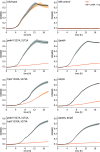Validation of aminodeoxychorismate synthase and anthranilate synthase as novel targets for bispecific antibiotics inhibiting conserved protein-protein interactions
- PMID: 38700332
- PMCID: PMC11107160
- DOI: 10.1128/aem.00572-24
Validation of aminodeoxychorismate synthase and anthranilate synthase as novel targets for bispecific antibiotics inhibiting conserved protein-protein interactions
Abstract
Multi-resistant bacteria are a rapidly emerging threat to modern medicine. It is thus essential to identify and validate novel antibacterial targets that promise high robustness against resistance-mediating mutations. This can be achieved by simultaneously targeting several conserved function-determining protein-protein interactions in enzyme complexes from prokaryotic primary metabolism. Here, we selected two evolutionary related glutamine amidotransferase complexes, aminodeoxychorismate synthase and anthranilate synthase, that are required for the biosynthesis of folate and tryptophan in most prokaryotic organisms. Both enzymes rely on the interplay of a glutaminase and a synthase subunit that is conferred by a highly conserved subunit interface. Consequently, inhibiting subunit association in both enzymes by one competing bispecific inhibitor has the potential to suppress bacterial proliferation. We comprehensively verified two conserved interface hot-spot residues as potential inhibitor-binding sites in vitro by demonstrating their crucial role in subunit association and enzymatic activity. For in vivo target validation, we generated genomically modified Escherichia coli strains in which subunit association was disrupted by modifying these central interface residues. The growth of such strains was drastically retarded on liquid and solid minimal medium due to a lack of folate and tryptophan. Remarkably, the bacteriostatic effect was observed even in the presence of heat-inactivated human plasma, demonstrating that accessible host metabolite concentrations do not compensate for the lack of folate and tryptophan within the tested bacterial cells. We conclude that a potential inhibitor targeting both enzyme complexes will be effective against a broad spectrum of pathogens and offer increased resilience against antibiotic resistance.
Importance: Antibiotics are indispensable for the treatment of bacterial infections in human and veterinary medicine and are thus a major pillar of modern medicine. However, the exposure of bacteria to antibiotics generates an unintentional selective pressure on bacterial assemblies that over time promotes the development or acquisition of resistance mechanisms, allowing pathogens to escape the treatment. In that manner, humanity is in an ever-lasting race with pathogens to come up with new treatment options before resistances emerge. In general, antibiotics with novel modes of action require more complex pathogen adaptations as compared to chemical derivates of existing entities, thus delaying the emergence of resistance. In this contribution, we use modified Escherichia coli strains to validate two novel targets required for folate and tryptophan biosynthesis that can potentially be targeted by one and the same bispecific protein-protein interaction inhibitor and promise increased robustness against bacterial resistances.
Keywords: antibiotic resistance; antibiotic target validation; enzyme complex; glutamine amidotransferases; protein-protein interactions.
Conflict of interest statement
The authors declare no conflict of interest.
Figures




Similar articles
-
Reprogramming the Specificity of a Protein Interface by Computational and Data-Driven Design.Structure. 2021 Mar 4;29(3):292-304.e3. doi: 10.1016/j.str.2020.11.013. Epub 2020 Dec 8. Structure. 2021. PMID: 33296666
-
Structure of Escherichia coli aminodeoxychorismate synthase: architectural conservation and diversity in chorismate-utilizing enzymes.Biochemistry. 2002 Feb 19;41(7):2198-208. doi: 10.1021/bi015791b. Biochemistry. 2002. PMID: 11841211
-
Conversion of aminodeoxychorismate synthase into anthranilate synthase with Janus mutations: mechanism of pyruvate elimination catalyzed by chorismate enzymes.Biochemistry. 2015 Apr 14;54(14):2372-84. doi: 10.1021/acs.biochem.5b00013. Epub 2015 Apr 2. Biochemistry. 2015. PMID: 25710100
-
Anthranilate synthetase.Adv Enzymol Relat Areas Mol Biol. 1973;38:1-39. doi: 10.1002/9780470122839.ch1. Adv Enzymol Relat Areas Mol Biol. 1973. PMID: 4275326 Review. No abstract available.
-
Bacterial fatty acid metabolism in modern antibiotic discovery.Biochim Biophys Acta Mol Cell Biol Lipids. 2017 Nov;1862(11):1300-1309. doi: 10.1016/j.bbalip.2016.09.014. Epub 2016 Sep 23. Biochim Biophys Acta Mol Cell Biol Lipids. 2017. PMID: 27668701 Free PMC article. Review.
Cited by
-
Activity Regulation of a Glutamine Amidotransferase Bienzyme Complex by Substrate-Induced Subunit Interface Expansion.ACS Catal. 2025 Mar 7;15(5):4359-4373. doi: 10.1021/acscatal.4c07438. Epub 2025 Feb 26. ACS Catal. 2025. PMID: 40365074 Free PMC article.
References
-
- Jonas OB, Irwin A, Berthe FCJ, Le Gall FG, Marquez PV. 2017. Drug-resistant infections: a threat to our economic future. In Final report. HNP/Agriculture global antimicrobial resistance initiative. World Bank Group, Washington, DC.
-
- Tacconelli E, Carrara E, Savoldi A, Harbarth S, Mendelson M, Monnet DL, Pulcini C, Kahlmeter G, Kluytmans J, Carmeli Y, Ouellette M, Outterson K, Patel J, Cavaleri M, Cox EM, Houchens CR, Grayson ML, Hansen P, Singh N, Theuretzbacher U, Magrini N, WHO Pathogens Priority List Working Group . 2018. Discovery, research, and development of new antibiotics: the WHO priority list of antibiotic-resistant bacteria and tuberculosis. Lancet Infect Dis 18:318–327. doi:10.1016/S1473-3099(17)30753-3 - DOI - PubMed
-
- Liu Y-Y, Wang Y, Walsh TR, Yi L-X, Zhang R, Spencer J, Doi Y, Tian G, Dong B, Huang X, Yu L-F, Gu D, Ren H, Chen X, Lv L, He D, Zhou H, Liang Z, Liu J-H, Shen J. 2016. Emergence of plasmid-mediated colistin resistance mechanism MCR-1 in animals and human beings in China: a microbiological and molecular biological study. Lancet Infect Dis 16:161–168. doi:10.1016/S1473-3099(15)00424-7 - DOI - PubMed
Publication types
MeSH terms
Substances
Grants and funding
LinkOut - more resources
Full Text Sources
Medical

